Perfect Fishing
Hooray! Photo success on Blogger!

Hard to see the net in this photo; the red dot on the left is actually a 2-ft diameter round float at the far end of the net, which stretches in a "C" shape back to the bow of the boat.
Friday was one of those amazing days that you just can’t plan for. The weather in southwest Alaska is fickle and changes rapidly. One day it is 75 degrees, sunny and beautiful, the next day it is 40 degrees, windy and raining. “Weather permitting” is a well-worn phrase around here, and nearly as applicable in summer as in winter. For many people here, fishing is not so much a pleasure as a requirement; salmon is the basis of survival, and getting it is time-limited. When the fish are running, you have to be out there, in all but the very worst weather. So you take the extra gear along and hope you won’t need it.
Friday it was time to go fishing again. The catch from the fourth of July was almost frozen solid in Henry’s big freezer, and the reds and kings that Betty and Andrea had cut and dried were in the smokehouse. Joan and I were ready to start getting our fish. We both want reds; Joan has her own smokehouse, and will dry and smoke them in the traditional manner. I don’t have a smokehouse, so I fillet and freeze my salmon in ziplock bags of water. The reds are well preserved this way, and Dutch and I will eat great-tasting salmon all winter long.
High tide was in the late afternoon, so Henry and Joan and I went out just before noon. The skies were overcast, but it wasn’t windy, which is nearly ideal. When the sun is shining brightly, the fish can see the net and swim around it; and low wind makes it much easier to handle the boat and the net. A little breeze is nice to keep the mosquitoes off, and that was just what we had.
Our goal was not to catch too many fish. The fourth of July catch was just TOO big. That many fish (over 400) is one heck of a lot of work. We were shooting for maybe a hundred fish, but more importantly, a better red-to-chum ratio. Henry’s freezer had room to hang one tote of chum, about 75 fish. The last two trips had yielded about 10% reds and kings and 90% chum; we were hoping to get 25% reds on this trip.
.Picking fish from the net.
About five miles upriver from Bethel, Henry pulled in to a different spot than we usually fish. There was not another boat in sight (one way to tell if a spot is any good) but Henry had a good feeling about the place, so we put the net out and waited. 
The tide was coming in strongly, so the river’s current did not move us at all, we just sat in one spot. That is usually a hopeful sign; salmon tend to migrate upriver in “pulses” with the tide. Swimming is easier, and it conserves their strength.
.Red salmon (also known as sockeye). My personal favorite for eating fresh or for freezing. Dries well also, though not as oily as king.
.
.
.Chum salmon (also known as dog). The red bruised-looking water marks will increase the longer the fish spends in fresh water. By the time they reach their spawning grounds, they are red all over. Great dog food.
.
.
A float bobbed here and there, so we knew we were catching fish, but they weren’t crashing the net. We ate the picnic lunch I brought, and had a half hour to drink coffee and enjoy the river.
It was so peaceful and quiet; just water lapping the sides of the boat, a few birds singing here and there. Breeze keeping the mosquitoes off. Sun in and out behind some clouds, just warm enough.
.
.King salmon (also called chinook). Really small ones like this are often referred to as "jacks". Normal size for this guy is about 4 times this big.
.
.
.
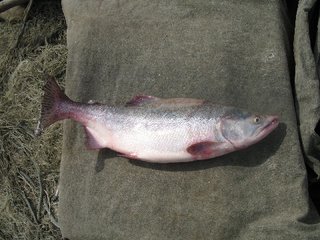
When we started to pull the net in, the results were immediately exciting. The first three fish were reds! There were plenty of chums also, and a few humpies (also dog food up here, but sold in the lower 48 as canned “pink” salmon). We did a second drift of about the same length with similar results.
.Humpback, or humpy, named for the hump in front of his dorsal fin. Meat is not very red, tends to be mushy, and has a mild watery flavor.
.
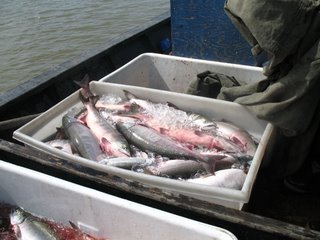 .
.
By the time we finished the second drift, the tide was turning and starting to ebb. We had one full tote of chums and humpies for the dogs, and 36 reds and 4 small kings for Joan and me. There were even three fat whitefish for Henry, who was thrilled. He loves whitefish even better than salmon, and we don't often catch them in the summer. We got exactly what we wanted, and at a far more relaxed and enjoyable pace of fishing.
.A tote full of chums and a half tote of reds and jacks. Just right.
The sun was out in full now, and the sky had only a few clouds. Once the work is done, when the weather is nice we love to pull over to the side of the river, take off the heavy gear, and just relax. Talk. Drink coffee. Maybe take a nap, or even go swimming if it is really hot. We’d been talking about birds earlier, so Henry and I both wanted to visit the cliff swallow colony at The Bluff, a big dirt cliff not far from Bethel. There are hundreds of holes in the face of the cliff, made by nesting swallows.
We pulled over to the edge of the river just at the foot of The Bluff and cut the motor. We didn’t need to throw the anchor out, as the river still wasn’t moving much yet. A few birds came and went from the nesting holes. We weren’t talking much, just lying in the bottom of the boat watching the sky. Joan asked with eyes closed and a smile on her face, “don’t you just hate living here?” And Henry responded, “ummmmm, yeah. Requires so much sacrifice.”
.
.
.
In a few minutes there were more birds flying in and out of the holes; and then more…and more…and more. The sky was alive with hundreds of wheeling, swooping, diving, loudly chirping swallows. Swallows are incredibly acrobatic flyers. It was an amazing sight. The agitation level was becoming intense, and we were clearly the source, so we cranked up the motor and cruised off. Of course it put me in mind of Hitchcock’s movie The Birds.
Back at Henry’s, we quickly hung the single tote of chum in the freezer. The reds and kings went into coolers for Joan and me to take home. I picked out the prettiest red in my batch to cook on the grill for Dutch’s birthday dinner last night (Happy Birthday, my love!). It was perfect—just like the day in which it was caught.
Henry, ever the voracious reader, provided the quote of the day adapted from a book he is currently reading, A Sense of the World by Jason Roberts: Life on the river quickens the stagnant blood and enlivens the nerves. Um, yeah. Definitely.
Labels: Life in Bethel



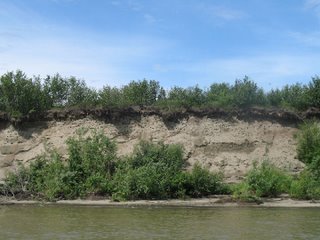
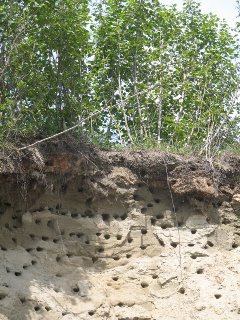

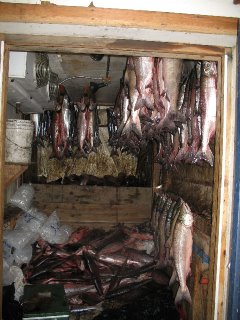




4 Comments:
Wow ... cool post. I learned so much about salmon and salmon fishing.
Good info and nice pics. So the salmom I get in the can at my local Wal Mart would be sold in the dog food section in Alaska? I need to get a better grade of salmon!
Your stories are fascinating! I am really interested to learn about the salmon fishing and how you manage to fish with nets like that. There must be a lot of salmon if net fishing can be sustained.
Thanks for posting all the photos it is really giving me a sense of what it must be like in Alaska.
Jill--glad you enjoyed it. Salmon is a big part of my summer. I love reading your blog; your cycling inspires me to do more myself.
Al--maybe you need to come up here and catch your own! You'll never eat the canned stuff again.
David--thank you very much! Yes, there is quite a lot of salmon in this river. The chum run in the Kuskokwim this year is estimated at 4 million. The king run is estimated at 1.5 million. The silvers will probably come in at 5 million or so in August. That's a lot of fish. I'm glad you like the photos; I think this place would be hard to imagine without them.
Post a Comment
<< Home